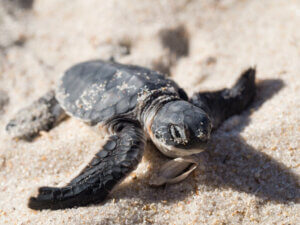The Effects of Illegal Trade on Animals

Unfortunately, the effects of the illegal trade on animal species are devastating. For this reason, authorities always look for new ways to combat it, and to stop those who practice it.
Do you know all the effects of this type of animal abuse, and its repercussions on the fauna and flora? We’ll now talk about illegal trade and how it’s combated, and we’ll show you a piece of news as a practical example.
Using decoys to track illegal trade
In October 2020, encouraging news emerged in the fight against illegal trade in animals. The news was about tracking the illegal sale of turtle eggs in Costa Rica, from thieves to consumers.
Fake green sea turtle and/or olive ridley sea turtle eggs were used as decoys. A 3D printer was used to create these realistic imitations, called InvestEggators.
After their manufacture, they were strategically placed in 101 turtle nests located on four different beaches. Of all these eggs, thieves pillaged approximately a quarter of them.
The catch is that these eggs included a GPS tracker which made it possible, in some cases, to trace their path. The decoys transmitted their exact position every hour.
However, some failed when they moved to areas with no signal, and others didn’t fool the thieves. Nevertheless, in many cases it’s been possible to identify the passage from the thief to the trafficker, and from the latter, to the consumer.
As a result, law enforcement bodies tracked the eggs, thus enabling them to dismantle illegal trading networks and toughen the penalties for criminals. Even so, they’ve noted that a large part of these animal products remain in the local communities, so they’re going to invest in an awareness campaign.
Furthermore, some of the GPS eggs went into the country, while others traveled outside of it. On the other hand, experts made sure that decoys wouldn’t affect the embryos in incubation.

Some details about the illegal trade
Firstly, illegal trade is “the sale of any legally prohibited goods in the country”. Also known as “Estraperlo”, it involves both fauna and flora from all over the world.
Records show that the illegal sale of fauna and flora has been occurring since 10,000 B.C. This economic activity outside of the legal ambit is highly lucrative. Consequently, numerous species of animals and plants were removed from their natural habitat.
What are its effects on species?
The consequences of the illegal trade are multiple because it doesn’t only affect the transferred species. Many of them return into the wild when their owners are no longer able to care for them.
This might seem like good news, but nothing could be further from the truth. As a consequence, the native living beings of the area may disappear because of these invasive species. All the ecosystems in the world have suffered the negative effects of the presence of these species:
- Depredation: Studies show that invasive raccoons feed on different animals and plants, such as crayfish, Galapagos tortoise eggs, water birds or fruits and grains, among others.
- Competition: Fighting for resources, as is the case between the European pond turtle and the red-eared slider.
- Hybridization: Genetic hybridization means, in the long run, the loss of species.
- Changes in the ecosystems.
- Negative influence on flora: Due to consumption, excavation, damage to plants or trees, as well as other damage. An example are the birds, such as the Argentinean parrots and their huge nests, which break the branches of trees.
- Transmission of disease and/or parasites: The raccoon, in spite of its funny mask face, can transmit diseases such as rabies.
The techniques used for combating illegal trade
As we’ve seen, the use of the decoy technique has allowed progress in the eradication of illegal trade. Despite this, the researchers of this study have concluded that several steps are necessary to reach the real objective:
- Multiple conservation efforts: Applying various conservation techniques, both in situ and ex situ.
- Awareness from an early stage: For example, Spain implemented a Code of Conduct in order to avoid future problems with invasive fauna.
- Creation of new jobs: This way, people won’t risk stealing eggs in order to resell them for extra money.
- Enforcement and legal improvement: Currently, laws against the poaching of turtle eggs are very light. Legislative strengthening is necessary.
- Education on the role of invasive species: Good practices to raise awareness regarding the prevention of illegal trade aren’t enough. We must also protect the native flora and fauna of each country.

In conclusion, the effects of the illegal trade are more serious and complex than we thought. Not only are the traded species in danger, but it can also harm the native species of the area.
That’s why we must fight against the illegal trade of fauna and flora, starting with awareness and education. Only in this way can we put an end to such a lucrative and immoral business.
Unfortunately, the effects of the illegal trade on animal species are devastating. For this reason, authorities always look for new ways to combat it, and to stop those who practice it.
Do you know all the effects of this type of animal abuse, and its repercussions on the fauna and flora? We’ll now talk about illegal trade and how it’s combated, and we’ll show you a piece of news as a practical example.
Using decoys to track illegal trade
In October 2020, encouraging news emerged in the fight against illegal trade in animals. The news was about tracking the illegal sale of turtle eggs in Costa Rica, from thieves to consumers.
Fake green sea turtle and/or olive ridley sea turtle eggs were used as decoys. A 3D printer was used to create these realistic imitations, called InvestEggators.
After their manufacture, they were strategically placed in 101 turtle nests located on four different beaches. Of all these eggs, thieves pillaged approximately a quarter of them.
The catch is that these eggs included a GPS tracker which made it possible, in some cases, to trace their path. The decoys transmitted their exact position every hour.
However, some failed when they moved to areas with no signal, and others didn’t fool the thieves. Nevertheless, in many cases it’s been possible to identify the passage from the thief to the trafficker, and from the latter, to the consumer.
As a result, law enforcement bodies tracked the eggs, thus enabling them to dismantle illegal trading networks and toughen the penalties for criminals. Even so, they’ve noted that a large part of these animal products remain in the local communities, so they’re going to invest in an awareness campaign.
Furthermore, some of the GPS eggs went into the country, while others traveled outside of it. On the other hand, experts made sure that decoys wouldn’t affect the embryos in incubation.

Some details about the illegal trade
Firstly, illegal trade is “the sale of any legally prohibited goods in the country”. Also known as “Estraperlo”, it involves both fauna and flora from all over the world.
Records show that the illegal sale of fauna and flora has been occurring since 10,000 B.C. This economic activity outside of the legal ambit is highly lucrative. Consequently, numerous species of animals and plants were removed from their natural habitat.
What are its effects on species?
The consequences of the illegal trade are multiple because it doesn’t only affect the transferred species. Many of them return into the wild when their owners are no longer able to care for them.
This might seem like good news, but nothing could be further from the truth. As a consequence, the native living beings of the area may disappear because of these invasive species. All the ecosystems in the world have suffered the negative effects of the presence of these species:
- Depredation: Studies show that invasive raccoons feed on different animals and plants, such as crayfish, Galapagos tortoise eggs, water birds or fruits and grains, among others.
- Competition: Fighting for resources, as is the case between the European pond turtle and the red-eared slider.
- Hybridization: Genetic hybridization means, in the long run, the loss of species.
- Changes in the ecosystems.
- Negative influence on flora: Due to consumption, excavation, damage to plants or trees, as well as other damage. An example are the birds, such as the Argentinean parrots and their huge nests, which break the branches of trees.
- Transmission of disease and/or parasites: The raccoon, in spite of its funny mask face, can transmit diseases such as rabies.
The techniques used for combating illegal trade
As we’ve seen, the use of the decoy technique has allowed progress in the eradication of illegal trade. Despite this, the researchers of this study have concluded that several steps are necessary to reach the real objective:
- Multiple conservation efforts: Applying various conservation techniques, both in situ and ex situ.
- Awareness from an early stage: For example, Spain implemented a Code of Conduct in order to avoid future problems with invasive fauna.
- Creation of new jobs: This way, people won’t risk stealing eggs in order to resell them for extra money.
- Enforcement and legal improvement: Currently, laws against the poaching of turtle eggs are very light. Legislative strengthening is necessary.
- Education on the role of invasive species: Good practices to raise awareness regarding the prevention of illegal trade aren’t enough. We must also protect the native flora and fauna of each country.

In conclusion, the effects of the illegal trade are more serious and complex than we thought. Not only are the traded species in danger, but it can also harm the native species of the area.
That’s why we must fight against the illegal trade of fauna and flora, starting with awareness and education. Only in this way can we put an end to such a lucrative and immoral business.
All cited sources were thoroughly reviewed by our team to ensure their quality, reliability, currency, and validity. The bibliography of this article was considered reliable and of academic or scientific accuracy.
- Decoy turtle eggs put in nests to track illegal trade in Costa Rica. The Guardian. Recogido a 18 de Octubre de 2020 en: https://www.theguardian.com/environment/2020/oct/05/decoy-turtle-eggs-put-in-nests-to-track-trade-in-costa-rica
- Comercio internacional de fauna: causas, consecuencias y posibles soluciones. Tesis Doctoral, Universida de Málaga, España; 2019. Recogido a 18 de Octubre de 2020 en: https://riuma.uma.es/xmlui/bitstream/handle/10630/18762/TD_SOUVIRON_PRIEGO_Lucrecia_Beatriz.pdf?sequence=1&isAllowed=n
- Código de conducta para evitar el comercio de fauna exótica invasora. Colvema.org (participa el Ministerio de Agricultura, Alimentación y Medio Ambiente). Recogido a 18 de Octubre de 2020 en: https://www.colvema.org/pdf/CFaunaweb_final_15012015.pdf
This text is provided for informational purposes only and does not replace consultation with a professional. If in doubt, consult your specialist.








